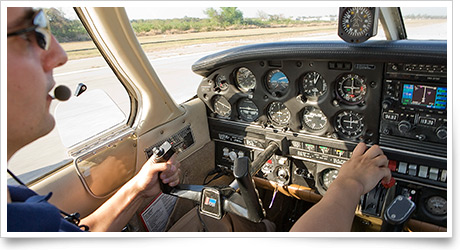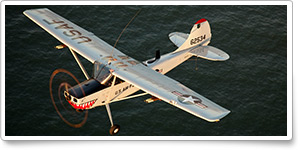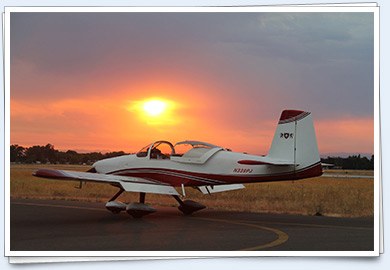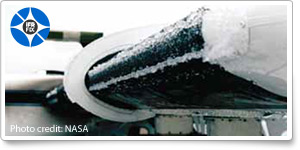Oct. 26, 2012, issue of 'AOPA ePilot: Flight Training Edition' weekly newsletter
| ||||||
| All clear on final? |
| |||||
Training TipsAll clear on final?
Suddenly your radio comes alive with a harried voice announcing a go-around. Because numerous airports share your local common traffic advisory frequency, it takes you a moment to realize that you may have caused the other pilot to balk a landing.
Not a good feeling; you try your best to maintain situational awareness, especially at a nontowered airport where you lack the reassuring backup of air traffic control overseeing air and surface movements.
This is also a major distraction, so maintain control of your aircraft! And try to spot the other aircraft.
Just as a conscientious pilot performs clearing turns airborne during the practice of maneuvers, ascertaining that there is no conflicting traffic is prerequisite to takeoff. It’s not enough to hear no chatter on the CTAF, or to assume that an inbound aircraft reporting a few miles out is the only local traffic.
Sometimes, you have to take extra pains to confirm that the pattern is clear. Not every airport has a spacious runup area just short of the runway threshold. Or, the space available for positioning your aircraft may not provide an ideal view of the traffic pattern.
Despite such constraints, strive to meet the standard that would apply on a practical test, namely that an applicant “ avoids runway incursions and ensures no conflict with traffic prior to taxiing into takeoff position.”
If you find that you must wait for a previously unseen (or unreported) aircraft, hold short of the runway. Then scan the pattern one more time before taxiing out (after the arriving aircraft has completely cleared).
Returning for landing after your flight, keep track of taxiing aircraft, and stay alert to the possibility that you may be the one who must react to a runway interloper. Such occurrences happen often enough that many pilots perform their first real-world go-around in such circumstances.
If you ever wondered why one element of a proper go-around is to “maneuver to the side of the runway,” this scenario provides the explanation: Doing so helps you “clear and avoid conflicting traffic,” as the test standard requires. Flight Training NewsRedbird: Simulation in training worksBy using full-motion flight simulators, one school is cutting flight time in airplanes to 38 hours for private pilot applicants. Redbird Skyport’s Roger Sharp laid out the progress of what the company calls a “flight training laboratory” over the past year during the company’s second annual Migration Flight Training Industry and Design Conference. Read more >> FAA tightening LSA inspection rulesFAA and designated inspectors are now required to notify FAA headquarters when a new light sport aircraft (LSA) make or model is presented for approval, or when a new company issues its first model. The notification is to allow the FAA's aircraft certification group, called AIR-200, to determine if an aircraft conformity inspection is required. Some in the LSA industry have complained that the requirement constitutes a speed-up in FAA plans to inspect all new LSA models starting in March 2013. Read more >> Talk about maintenance at the November chatHow much do you know about your trainer’s engine? What should you know about maintenance—particularly if you’re thinking about buying an airplane? Talk about all things related to aircraft maintenance at the November Flight Training Facebook chat. Our guest chatter will be AOPA Senior Aviation Technical Specialist Craig Brown, who holds an airframe and powerplant certificate. Join us at 3 p.m. Eastern on Nov. 6. Log on to the Flight Training Facebook page to set an email reminder and view transcripts of previous chats. FlightSafety founder leaves training legacyGrowing up in rural Kentucky, Albert Lee Ueltschi became fascinated with aviation at a young age, spurred by Charles Lindbergh’s trans-Atlantic flight. That passion and his entrepreneurial spirit led to him soloing at age 16 and later earning his pilot certificate, ultimately founding what has become a first-class worldwide training center: FlightSafety International. Ueltschi, 95, died Oct. 18 at his home in Vero Beach, Fla. Read more >> Training Resources’Tis the seasonAs the tilt of the Earth’s axis turns the Northern hemisphere away from the sun during autumn, temperatures will begin to drop and fall will give way to winter. Lower temperatures are frequently connected with lower sky ceilings and reduced visibilities. Learn about the conditions that lead to these situations, and how to find and avoid them easily, by taking the Air Safety Institute’s WeatherWise: Ceiling and Visibility online course.
Did you know that student pilots who join AOPA are three times more likely to complete their flight training? Membership includes unlimited access to aviation information by phone (800/USA-AOPA, weekdays from 8:30 a.m. to 6 p.m. Eastern time) or from Flight Training Online or AOPA Online. If you’re not already a member, join today and get the pilot’s edge. Login information is available online. Waco flight to Palm Springs Career PilotAlaska orders 50 new Boeing 737sAlaska Airlines announced an order for 50 new Boeing aircraft, including the new 737 MAX variant of the Boeing 737, on Oct. 11. The aircraft will be delivered between 2015 and 2022; worth $5 billion at manufacturers' list prices, they represent the largest order in Alaska Airlines’ history. The agreement includes firm orders for 13 Boeing Next-Generation 737-900ERs, 20 737 MAX 8s, and 17 737 MAX 9s. Alaska, which currently operates 120 Boeing 737s, said the new order—plus 25 existing delivery positions—gives it the flexibility to manage its fleet size to meet air travel demand over the next decade. US Airways flight attendants to take strike voteLeaders of the flight attendants at US Airways, represented by the Association of Flight Attendants-CWA (AFA), announced a strike vote Oct. 10 to back up their demands for a single contract in the US Airways/America West merger. The strike vote will open Oct. 31 and close Nov. 20. “The decision to take a strike vote is not made lightly. It was the result of full deliberation of all strategic options,” union leaders said. Plane SpotterGround spotter: Cessna L-19 Training ProductsFLYpad notebookThe FLYpad notebook from PilotMall.com is a spiral notebook that includes a set of sticky notes of different sizes, so you can jot clearances or weather information and use the notes for reminders wherever they're needed. The pad is sized at 3.5-by-5.5 inches and includes 80 lined pages as well as two 24-piece sticky note pads attached to the first page. The back cover holds an elastic loop with a short pen. Priced at $4.99, the FLYpad can be ordered online or by calling 800/249-5730.
Note: Products listed have not been evaluated by ePilot editors unless otherwise noted. AOPA assumes no responsibility for products or services listed or for claims or actions by manufacturers or vendors. Member BenefitsSpecial issuance authorization updateDo you have a special issuance medical? You may recall that your previous authorization letters included a statement that required you to carry your letter with you when you fly. That rule has been changed, AOPA Director of Medical Certification Gary Crump explains. Read more and learn about AOPA Pilot Protection Services >> EA+ helps ill woman get home from MexicoAs Americans travel abroad in record numbers, some companies are offering “medical repatriation” services to bring sick travelers home safely and more affordably. But many people are surprised at how costly a medical emergency can be, especially out of the country. That’s why programs such as AOPA Emergency Assistance Plus (EA+) are so important. Read how EA+ helped a traveler in Mexico and saved her thousands of dollars in the process. Read more >> BlogsThe noncompeting competitive competitorsWhen it comes to fares, fees, and frequent flyer programs, the airlines are as competitive as you’d expect. But there’s one area in which they’re not competitive at all. Read more from professional pilot Chip Wright. Also in this week's Flight Training blog, Technical Editor Jill W. Tallman shares one pilot’s very simple idea for spreading excitement about aviation—and you can do it, too. Strange but true general aviation newsWhy you just got pulled over by a Cessna Skyhawk, the woman who hopes to visit all 50 states by GA, and the aircraft accident that wasn’t. Read these headlines and more in AOPA e-Newsletter and Social Media Editor Benét J. Wilson’s roundup in the Reporting Points blog. AOPA Career OpportunitiesEver dream of turning your passion for aviation into a career? We’re looking for a member services representative; manager, AOPA Flying Club Network; marketing production specialist; contract administrator; accounts receivable/payable technician; Web developer (eMedia); strategy and financial analyst; director of media relations; major gifts officer; and Web graphic designer. To learn more about other AOPA career opportunities, visit AOPA Online. Community
AVIATION EVENTS & WEATHER
| ||||||||||||||||||||||||||||||||||||




 Pre-takeoff checks are complete. The engine ran up perfectly, and you are ready for takeoff. Positioning the aircraft on the runway center line, you add power, and a touch of right rudder, and begin the takeoff run.
Pre-takeoff checks are complete. The engine ran up perfectly, and you are ready for takeoff. Positioning the aircraft on the runway center line, you add power, and a touch of right rudder, and begin the takeoff run.





